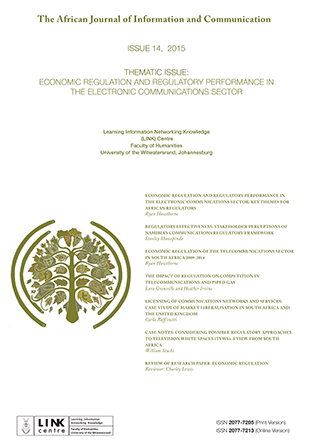Case Notes: Considering Possible Regulatory Approaches to Television White Spaces (TVWS): A View from South Africa
DOI:
https://doi.org/10.23962/10539/20347Abstract
South Africa is one of the countries in the SADC region carrying out research and tests of television white space (TVWS) technology. TVWS technology, and dynamic spectrum management generally, have the potential to increase significantly the usage of valuable spectrum, that is considered to be scarce, and hence reduce the perceived scarcity. In so doing, TVWS technology has the potential to facilitate greater coverage and penetration of broadband in South Africa. However, this requires a paradigm shift from the traditional manually approved spectrum licensing process, usually on an exclusive basis, to an automated, dynamic process, where spectrum is shared between many users, some of whom will be assigned a higher priority than others. This can be achieved using a geo-location database, which implements complex radio propagation modelling and assigns permissions to use spectrum according to rules specified by the regulator. This, however, requires a new regulatory approach to spectrum assignment. A multi-level use approach is proposed ranging from protected exclusive, through protected secondary. to unprotected licence-exempt. None of these uses may cause interference to a higher level.
References
ABIresearch (2012). Wireless connectivity chipsets revenues to exceed $10 billion in 2012, WiFi chipsets account for 40% of the market. Available from https://www.abiresearch.com/press/wireless-connectivity-chipsets-revenues-to-exceed-
Carter, K., Lahjouji, A., & McNeil, N. (2003). Unlicensed and unshackled: A joint OSP-OET White Paper on unlicensed devices and their regulatory issues. Washington: Federal Communications Commission (FCC). Retrieved from http://www.fcc.gov/working-papers/unlicensed-and-unshackled-joint-osp-oet-white-paper-unlicensed-devices-and-their-regu
Cisco. (2014). Cisco visual networking index: Global mobile data traffic forecast update, 2013-2018. Available from http://www.cisco.com/c/en/us/solutions/collateral/service-provider/visual-networking-index-vni/white_paper_c11-520862.html
ECC. (2009, June). Light licensing, license-exempt and commons. ECC Report 132. Copenhagen, Denmark: Electronic Communications Committee (ECC) within the European Conference of Postal and Telecommunications Administrations (CEPT). Report presented in Moscow. Retrieved from http://www.erodocdb.dk/Docs/doc98/official/pdf/ECCRep132.pdf
FCC (2012, April 4). FCC 12-36 Third memorandum opinion and order. Unlicensed operation in the TV broadcast bands; Additional spectrum for unlicensed devices below 90MHz and in the 2GHz band. Washington: Federal Communications Commission (FCC). Retrieved from https://apps.fcc.gov/edocs_public/attachmatch/FCC-12-36A1.pdf
FCC (2014, September). FCC 14-144 Notice of proposed rulemaking. Washington: FCC. Retrieved from http://www.fcc.gov/document/part-15-nprm
Geerdts, C., Langenhorst, J., & Cull, D. (2014). White Paper: Optimal spectrum utilisation in South Africa to improve broadband services. Cape Town: Wireless Access Providers’ Association (WAPA). Retrieved from http://www.wapa.org.za/wp-content/uploads/2010/07/Optimal-Spectrum-Utilisation-in-South-Africa-WAPA-White-Paper-Version-1.01.pdf
Google and OTI (2008). A technology driven spectrum policy. Available from http://www.newamerica.net/files/Spectrum_Policy_Ireland_Google_OTI.pdf
Grootes, P. & Stucke W. (2013). The choices for high demand spectrum. Internal communication. Sandton: ICASA.
GSMA (2014). Public policy position paper: Mobile spectrum requirements and target bands for WRC-15. Available from http://www.gsma.com/spectrum/wp-content/uploads/2014/05/WRC-15-Public-Policy-Position-Paper-FINAL-ENGLISH.pdf
Hayes, V., & Lemstra, W. (2009). Licence-exempt: The emergence of WiFi. Info, 11(5), 57-71. http://dx.doi.org/10.1108/14636690910989333
ICASA (2011). Radio frequency spectrum licence fee regulations for electronic communication network services and electronic communication services 2010. Sandton: Independent Communications Authority of South Africa (ICASA). Available from https://www.icasa.org.za/LegislationRegulations/ExistingRegulations/MiscellaneousRegulations/RadioFrequencySpectrumRegulationsFees/RadioFrequencySpectrumFees/tabid/438/Default.aspx
ICASA (2012). Final radio frequency spectrum regulations and explanatory document. Government Gazette No. 34172. Available from https://www.icasa.org.za/LegislationRegulations/FinalRegulations/MiscellaneousRegulations/RadioFrequencySpectrum/tabid/721/ctl/ItemDetails/mid/2622/ItemID/1479/Default.aspx
ICASA. (2012). Calculating spectrum fees. Available from https://www.icasa.org.za/LegislationRegulations/EngineeringTechnology/RadioFrequencySpectrumLicensing/SpectrumFees/tabid/357/ctl/ItemDetails/mid/1204/ItemID/1189/Default.aspx
ICASA (2014). Final international mobile telecommunications roadmap 2014. Government Gazette No. 38213.
IETF (2011). Charter for Working Group: Protocol to access WS database (PAWS) Working Group,. Available from https://datatracker.ietf.org/wg/paws/charter/
IETF (2013, May). RFC 6953 Protocol to access White-Space (PAWS) databases: Use cases and requirements. Available from https://tools.ietf.org/html/rfc6953
IETF (2014, November). Protocol to access White-Space (PAWS) databases draft-ietf-paws-protocol-20. Available from https://datatracker.ietf.org/doc/draft-ietf-paws-protocol/
ITU and Infodev (n.d.). ICT regulators toolkit, Chapter 5: Radio spectrum management. Available from http://www.ictregulationtoolkit.org/5
Jun, E., Park, K., & Lee, B. (2012). Analyzing spectrum management policy for utilizing TV White Space. Proceedings of the International Conference on Systems and Electronic Engineering (ICSEE’2012), December 18-19, 2012. Phuket, Thailand.
Kim, Y., Kelly, T., & Raja, S. (2010). Building broadband: Strategies and policies for the developing world. Washington: World Bank. Retrieved from http://siteresources.worldbank.org/EXTINFORMATIONANDCOMMUNICATIONANDTECHNOLOGIES/Resources/282822-1208273252769/Building_broadband.pdf
Korowajczuk, L. (2011). LTE, WiMAX and WLAN design: Network design, optimisation and performance analysis. West Sussex, UK: Wiley. http://doi.org/10.1002/9781119970460
Mfupe, L., Mekuria, F., & Mzyece, M. (2014). Geo-location White Space spectrum databases: Models and design of South Africa’s first dynamic spectrum access coexistence manager. KSII Transactions on Internet and Information Systems, 8(11), 3810-3836. http://dx.doi.org/10.3837/tiis.2014.11.009
MIT. (2014). White Paper: Toward more efficient spectrum management: New models for protected shared access. Cambridge, US: MIT. Retrieved from http://cfp.mit.edu/publications/CFP_Papers/CFP%20Spectrum%20Sharing%20Paper%202014.pdf
Nitin, B. (2013). Press release: Mobile operators to see 50% of their data traffic transfer to WiFi & small cell networks this year. Juniper Research. Retrieved from http://www.juniperresearch.com/viewpressrelease.php?pr=381
Ofcom. (2013). Consultation paper: TV White Spaces: Approach to coexistence. London, UK: Ofcom. Retrieved from http://stakeholders.ofcom.org.uk/binaries/consultations/white-space-coexistence/summary/white-spaces.pdf
Pahl, J. (2007). Spectrum liberalisation and interference management. Retrieved from http://www.itu.int/osg/spu/stn/spectrum/workshop_proceedings/Background_Papers_Final/Spectrum%20Liberalisation%20and%20Interference%20Management.pdf
RSA (2013, December 6). South Africa Connect: Creating opportunities, ensuring inclusion: South Africa’s Broadband Policy. Pretoria: Republic of South Africa (RSA). Government Gazette No. 37119.
Stucke, W. (2013, April 17). Dynamic spectrum regulation in South Africa. Paper presented at 2nd Workshop on Smart Radio Technologies, CSIR Meraka Institute, Pretoria.
TENET. (2013). Recommendations and learnings from the Cape Town TV White Spaces trial. Available from http://www.tenet.ac.za/tvwsTENET. (2013). Suggested technical rules and regulations for the use of TVWS and managed access spectrum. Available from http://www.tenet.ac.za/tvws
Thanki, R. (2012). The economic significance of licence-exempt spectrum to the future of the Internet. Available from http://www.wirelessinnovationalliance.org/index.cfm?objectid=DC8708C0---D1D2---11E1---96E9000C296BA163
Thornton, L. (2008). High Court ruling paves the way for competition from alternative communications providers in South Africa. Available from http://thornton.co.za/altech-court-rulings-bna.php
USTTI (2011). Training provided to ICASA by the US Telecommunications Training Institute (USTTI), February 2011.
Williamson, B., Punton, T., & Hansell, P. (2013). Future proofing WiFi - the case for more spectrum. A report for CISCO. Available from http://www.plumconsulting.co.uk/pdfs/Plum_Jan2013_Future_proofing_Wi-Fi.pdf
Wu, R. (2014, March 11). Spectrum sharing theory and practice. Presentation to ICTP School on Applications of Open Spectrum and White Spaces Technologies. Retrieved from http://wireless.ictp.it/school_2014/Lectures/Day7/Spectrum-Sharing-Theory+Practice.pdf
Wyglinski, A., Nekovee, M., Hou, Y. (Ed.) (2010). Cognitive radio communications and networks: Principles and practice. Waltham, US: Academic Press. http://doi.org/10.1002/9781118376270
Downloads
Published
Issue
Section
License
Copyright (c) 2015 https://creativecommons.org/licenses/by/4.0

This work is licensed under a Creative Commons Attribution 4.0 International License.
How to Cite
- Abstract 258
- pdf 120


.png)